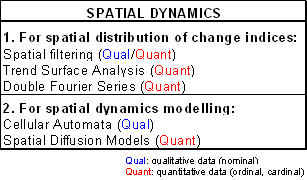|
|
Spatial Change Analysis
The main objective of spatial change analysis is to describe the structure and the pattern distribution of spatial changes.
Most spatial change analysis methods are developed in image mode as this mode offers a simpler and structured description
of spatial distributions, allowing the simultaneous analysis of:
- Change in spatial features (regions)
- Change in the spatial distribution of thematic properties (discrete or continuous)
Spatial change can be analysed at two levels:
- Through the spatial distribution analysis of thematic change indices
- Through the spatial dynamics modelling
There are various methods proposed to investigate the spatial dimension of time change.
We have already presented some of them applied to the description of the spatial distribution of properties:
for continuous (B-AN, Lesson 3. Kontinuierliche Räumliche Variablen) and discontinuous spatial distributions (B-AN, Lesson 2. Discrete Spatial variables and I-AN, Lesson 2. Discrete Spatial Variables).
As presented in the introductory Unit of this Lesson, methods are not only dependant on the objective of the analysis
or on the nature of the spatial distribution, but they are also related with the level of content of the thematic information.
Table 3.1 summarises methods used to investigate spatial changes
 Examples of spatial dynamics analysis methods
Examples of spatial dynamics analysis methodsLearning Objectives
- You will be able to select appropriate methods and techniques for a specific context of spatial dynamics analysis.
- You will master the basic principles of various spatial dynamics methods and be able to access to related text references for in depth learning.
